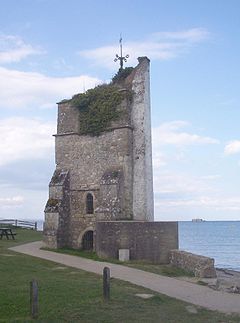St Helens, Isle of Wight
| St Helens | |
|---|---|
 St Helens Old Church |
|
| St Helens shown within the Isle of Wight | |
| Population | 1,213 (2011) |
| OS grid reference | SZ627890 |
| Civil parish |
|
| Unitary authority | |
| Ceremonial county | |
| Region | |
| Country | England |
| Sovereign state | United Kingdom |
| Post town | RYDE |
| Postcode district | PO33 |
| Dialling code | 01983 |
| Police | Hampshire |
| Fire | Isle of Wight |
| Ambulance | Isle of Wight |
| EU Parliament | South East England |
| UK Parliament | |
St Helens is a village and civil parish located on the eastern side of the Isle of Wight. The village developed around village greens. This is claimed to be the largest in England but some say it is the second largest. The greens are often used for cricket matches during the summer and football in the winter, and also include a children's playground. The local pub is the Vine. The village also has two restaurants, Ganders on the upper side of the green and Dan's Kitchen on the south.
The village is a short distance from the coast, about a ten-minute walk to St Helens Duver. The Duver was once the location of the island's first golf course (one of England's first golf courses), which for a while was almost as famous as the golf course at St Andrews. It is now a popular beach for tourists during the summer season and is protected by the National Trust.
It is linked to other parts of the island by Southern Vectis bus route 8 serving Ryde, Bembridge, Sandown and Newport including intermediate villages.
The origin of St Helens seems to revolve around the Cluniac Priory and the monastic church, built circa 1080. In 1340 a French raid landed at St Helens but was repulsed by Sir Theobald Russell. In 1346 Edward III set sail from St Helens to invade Normandy.
After Henry V suppressed the alien priories in 1414 the old church became the parish church. The original church eventually became unsafe and a new one was built further inland. In 1720 a great wave destroyed the old church, though the church tower still stands to this day; the seaward side is painted as a sea mark. It is believed that Admiral Lord Nelson's last view of England was of the St Helens seamark - HMS Victory had anchored nearby to collect drinking water, before setting sail for Cádiz and participation in the Battle of Trafalgar.
...
Wikipedia

